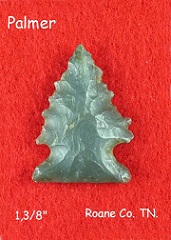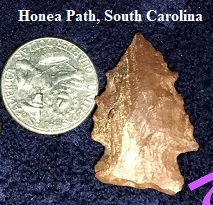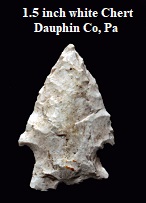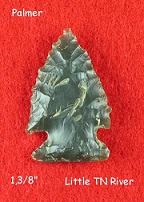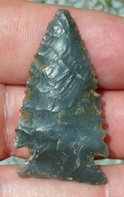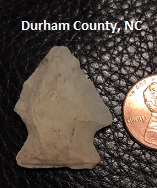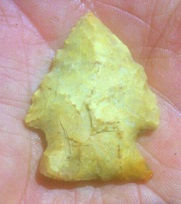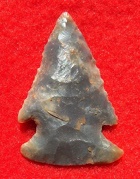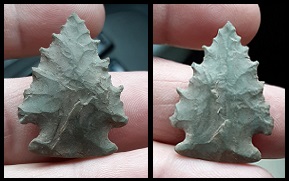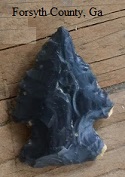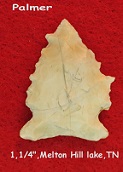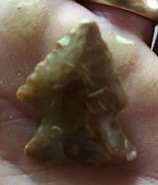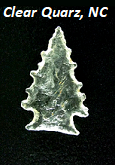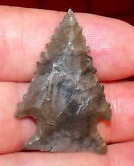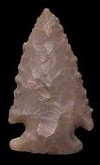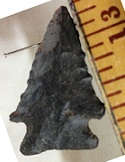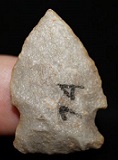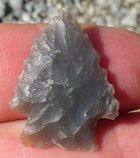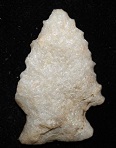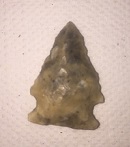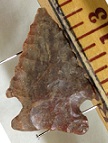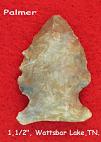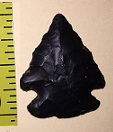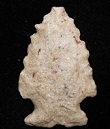Outline is Representative of Size and Shape:

Name Details:
Identified By: Joffre L. Coe
Named For: Palmer Mountain near Type Site
Date Identified: 1964
Type Site: Hardaway Site, Stanly County, North Carolina
Identified By: Joffre L. Coe
Named For: Palmer Mountain near Type Site
Date Identified: 1964
Type Site: Hardaway Site, Stanly County, North Carolina
Point Validity:
Valid type
Coe was a highly respected and pioneering anthropologist in North Carolina archaeology and a preeminent authority on eastern North American anthropology. This type was named in a professional publication and has many professional references. This is considered a valid type.
Palmer Corner Notch
AKA: Kirk Corner Notch (Small Variety)Cluster: Kirk Corner Notch Cluster
Description of Physical Characteristics and Flaking Pattern:
This is a small (less then 2 inches) triangular corner notch point with an elliptical cross section. The blade is primarily straight, but may vary to slightly incurvate or slightly excurvate. Serrated blades are common for this type. The shoulders are primarily barbed, but may be horizontal or slightly sloping upwards. The stem is expanding. The base is most commonly straight, but may vary from slightly convex to slightly concave. Heavy basal grinding and thinning are commonly seen giving the hafting region a smooth appearance. This point has a random flaking pattern.
Size Measurements:
Total Length - 23 to 60 mm (26 to 35 mm average), Stem Length - 4 to 12 mm (average 7 to 9 mm), Blade Width - 14 to 29 mm (19 to 22 mm average), Neck Width - 12 to 18 mm (14 to 16 mm average), Basal Width - 15 to 25 mm ( 17 to 21 mm), Thickness - 3 to 10 mm (average 8mm)
Total Length - 23 to 60 mm (26 to 35 mm average), Stem Length - 4 to 12 mm (average 7 to 9 mm), Blade Width - 14 to 29 mm (19 to 22 mm average), Neck Width - 12 to 18 mm (14 to 16 mm average), Basal Width - 15 to 25 mm ( 17 to 21 mm), Thickness - 3 to 10 mm (average 8mm)
Additional Comments:
Coe (1959) states, "Following the Hardaway occupation, the style of projectile points changed to a small corner-notched serrated variety with extensive grinding along the base. Along with this the use of the small hafted snub-nosed scraper increased considerably."
This point is thought to have evolved into the Kirk point (Coe, 1964), and the later Decatur point (W2).
John Whatley argues that small Bolen Corner Notch would be better classified as this type and large Bolen Corner Notch would be better classified as Kirk Corner Notch (Schroder, 2013).
Coe (1959) states, "Following the Hardaway occupation, the style of projectile points changed to a small corner-notched serrated variety with extensive grinding along the base. Along with this the use of the small hafted snub-nosed scraper increased considerably."
This point is thought to have evolved into the Kirk point (Coe, 1964), and the later Decatur point (W2).
John Whatley argues that small Bolen Corner Notch would be better classified as this type and large Bolen Corner Notch would be better classified as Kirk Corner Notch (Schroder, 2013).
Distribution: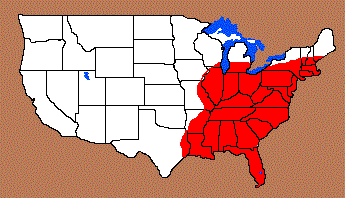
Distribution Comments:
This point is primarily associated with the Eastern Seaboard region of the United States, into the the Gulf Coastal region and the Tennessee River and Ohio River basins. This point is found into the Mississippi River Basin and the Northeastern United States with decreased frequency.
Age / Periods:
Date: 9,500 - 8,500 B.P.
Cultural Period: Early Archaic
Glacial Period: Early Holocene
Culture:
Date: 9,500 - 8,500 B.P.
Cultural Period: Early Archaic
Glacial Period: Early Holocene
Culture:
Age Details:
Coe (1964) felt that Palmer points were earlier than Kirk Comer Notched. However, Whatley (2002) notes that the temporal differentiation between the two comer-notched types is not well defined. He feels a case could be made for lumping the two types together.
Coe (1964) felt that Palmer points were earlier than Kirk Comer Notched. However, Whatley (2002) notes that the temporal differentiation between the two comer-notched types is not well defined. He feels a case could be made for lumping the two types together.
Other points in this cluster / Related / Associated Points:
Amos, Charleston Corner Notch, Decatur Kirk Corner Notch, Pine Tree Corner Notch, Stilwell
Amos, Charleston Corner Notch, Decatur Kirk Corner Notch, Pine Tree Corner Notch, Stilwell



